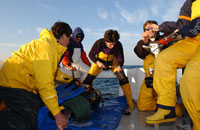It’s 6am and the
floodlights cast their rays on the back deck of the f/v Bay Queen IV in Murphy’s Pond, Port Hood’s small commercial fishing
port on the west coast of Cape Breton Island, Nova Scotia. Captain Dennis Cameron and mate Lloyd MacInnes
move around the deck coiling lines and crimping monofilament,
bantering over the low rumble of the inboard.
 |
| Murphy's Pond in Port Hood, Nova Scotia photo credit: R. Schallert |
We approach the dock
in our minivan loaded with crates of scientific gear and snacks for our day on
the water. Dr. Steve Wilson and Robbie Schallert of Stanford University and the
Tag-A-Giant Foundation lift a heavy silver crate and shuffle towards the
Bay Queen IV, greeting the crews of
the various vessels staging their gear in the grey light. The crate is full of acoustic and satellite
tags that, with luck, will be deployed on some of the largest tunas in the
world.
The TAG team has been
coming up to Nova Scotia every fall for the past 8 years and it shows. Robbie cracks jokes with Melvin, Troy, Carl
and more as we make our way down the floating dock. TAG has fostered lifelong
relationships within the Port Hood community to create a collaborative
environment; we couldn’t tag without their ocean expertise, and our research
contributes to the sustainable management of their local bluefin fishery.
 |
| Loading the bait well with mackerel in the morning light photo credit: E. Estess |
We shove off as the clouds turn a light pink hue. The first order of business, as with all fishing, is bait. Dennis eyes the echo sounder and quickly
shifts out of gear when he spots a school of mackerel. We keep the biggest mackerel in the live-well
and motor off towards the tuna grounds.
Once we’re in the zone Lloyd rigs up two of the thick rods with live mackerel and pink balloons as surface floats, and the third rod
is connected to a kite line to dangle a live mackerel at the surface. And now we wait.
Radio calls come in
from across the Gulf of St. Lawrence.
“Congratulations Bill, glad to hear you got your fish.” “We’re marking lots of fish over here boys.” Again, I take note of the friendly,
collaborative nature of the fishery. Canadians really are as nice as
people say! After hours of silence we
decide to pick up our lines and try another spot. More silence and no tuna
marks on the echo sounder.
 |
| Searching the Gulf of St. Lawrence for giant bluefin photo credit: R. Schallert |
This is our second
day on the water and the fishing has been silent. Not to mention the weather has been on the
rough side of the spectrum. Part of me
accepts that this is the nature of fishing- the bite is always hotter the week
before. It’s fishing, not catching. Am I wearing my lucky tuna belt? I didn’t
even bring any bananas on board. These
old catchphrases and superstitions drift through my mind as the hours flow on.
Deep down I know I’m
paying a karmic penance after my last trip up to Port Hood in 2013, when we
tagged up to 9 giant bluefin in a day and fished for 5 days straight in sunny,
flat calm conditions. I knew I was going
to have to pay some dues, and bouncing around in the cabin with my hands shoved
deep into my foul weather jacket to keep warm in the Arctic breeze, I accepted
my fate with a meditative mantra, “It’s fishing, not tagging.”
 |
| Wind on the water. Waiting for action. photo credit: E. Estess |
At that moment, I
watched the monofilament pull tight and the pink balloon float disappear. SNAP!
The rubber band holding the Teflon leader guard broke and it rocketed down the
line to protect the mono leader from the glass-sharp teeth of the giant tuna
below. BZZZZZZZZZZZ the line screamed
off the reel as Lloyd rocketed across the deck and started cranking away. Dennis began maneuvering the vessel, backing
down on the fish to gain slack in the 300lb test line like a boxer circling
their opponent in the ring. The rod bent
with strain as the fish made a run and Lloyd waited patiently for his chance to
gain line.
But as quickly as it
had come, the tuna jerked the hook from its mouth and was gone. Lloyd silently reeled in the slack line,
pausing to look at the bent hook. Strike
one, but after days of no action the reminder of the power of these animals was
enough inspiration. The fish are around.
They’re always on the move throughout the gulf waters as they hunt for herring
and mackerel, and it takes skill and decent dose of luck to line up on
them. Weather permitting, we will be
putting in our time these next weeks to tag and release these beautiful giants,
unlocking the secrets of their life history and migratory routes to inform the sustainable
management of the tuna fishery.
 |
| Hoping for an evening bite. photo credit: E. Estess |



